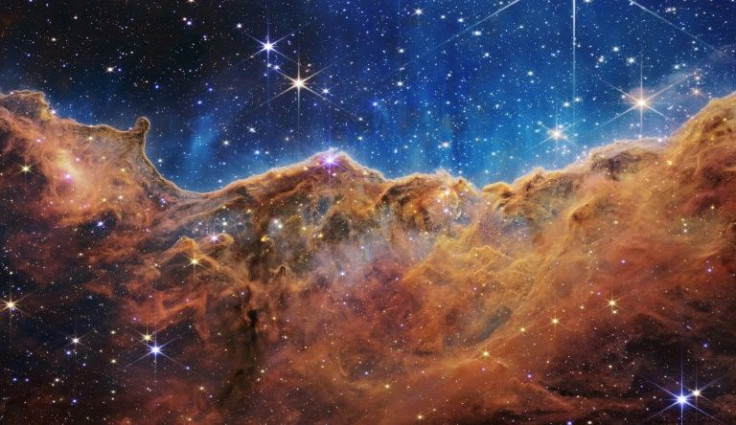This Stunning Webb Photo Was Hiding 'Buried Treasure' Of Young Star Formation
KEY POINTS
- Researchers analyzed one of the first Webb images
- They found signs of the "most exciting part of the star formation process"
- This could shed light on the formation of Sun-like stars
The first images from the James Webb Space Telescope (Webb/JWST) provided some stunning views of the universe. It turns out, one of them was hiding a "buried treasure" of young stars.
The images from Webb were first released in July. Among them was the breathtaking image of the star-forming region NGC 3324 in the Carina Nebula.
Hubble Space Telescope had previously captured an image of the region. A side-by-side comparison shows the difference between the images from the two space telescopes.
.@ESA_Webb is talking about #Webb and #Hubble right now, #BFFinSpace. Here's the Carina Nebula's 'Cosmic Cliffs' as seen by Webb alongside @HUBBLE_space's image. See more about how Hubble and Webb will work together and complement each other 👉 https://t.co/mdEeraVDw3 pic.twitter.com/fjzIbBFV5v
— ESA (@esa) August 17, 2022
Scientists taking a closer look at the now-iconic image have discovered a "buried treasure" that had been hiding behind the dust clouds in the region. In a paper, published in the Monthly Notices of the Royal Astronomical Society, the researchers described their discovery of "24 previously unknown outflows" from very young stars based on their molecular hydrogen (H2) emissions.
"Remember this view from Webb's first images? A deep dive has revealed young stars in an elusive stage of development — and may help us investigate how stars like our Sun form," NASA tweeted, sharing a stunning photo of the region.
Scientists found “buried treasure," and the Cosmic Cliffs marked the spot. 🏴☠️
— NASA Webb Telescope (@NASAWebb) December 15, 2022
Remember this view from Webb’s first images? A deep dive has revealed young stars in an elusive stage of development — and may help us investigate how stars like our Sun form: https://t.co/KWQysezIWq pic.twitter.com/5NuhT3n4Op
The Hubble telescope was able to see the outflows as well, but they were from "more evolved" objects. Molecular hydrogen is actually vital in the creation of new stars, the agency explained. And thanks to Webb's "sensitivity," it was able to spot these signals from younger star stages.
What the researchers discovered from the Webb image are "signposts for the most exciting part of the star formation process," study co-author Nathan Smith, of the University of Arizona, noted in a press release from NASA. This stage in the star formation is "relatively fleeting," which is why they're particularly hard to catch. And yet Webb was able to capture them.
While there were "hints" of such activity when the first images were released back in July, it was through a "deep diving" of the image that the researchers discovered these rather special features, team member Jon Morse, of the California Institute of Technology, explained.
"It's like finding buried treasure," Morse said.
This shows Webb's sheer capability. Together with data from Hubble, such information could shed further light not only on the star-forming region, but also on the formation of Sun-like stars.
"It opens the door for what's going to be possible in terms of looking at these populations of newborn stars in fairly typical environments of the universe that have been invisible up until the James Webb Space Telescope," said study lead Megan Reiter, of Rice University. "Now we know where to look next to explore what variables are important for the formation of Sun-like stars"
"As a relatively modest region of massive star formation (larger than Orion but smaller than starburst clusters), NGC 3324 offers a preview of what star formation studies with JWST may provide," the researchers wrote.

© Copyright IBTimes 2025. All rights reserved.






















